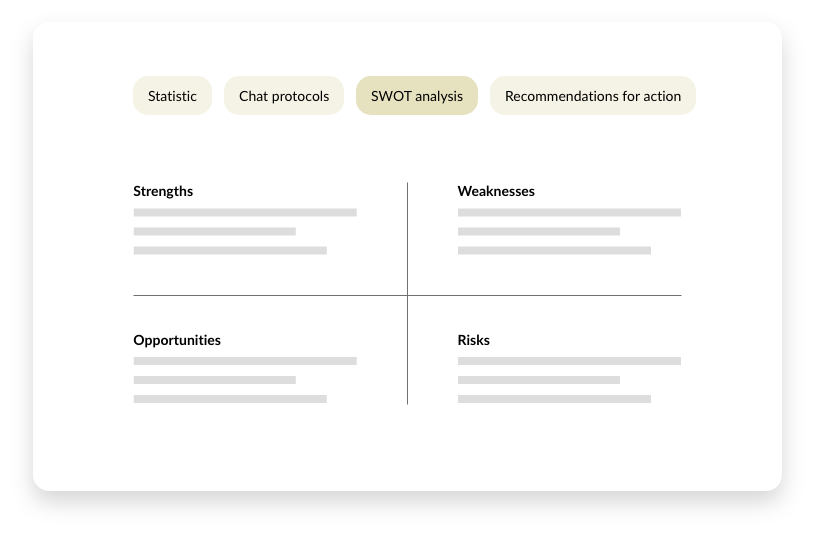Why is market analysis so important?
In a world where markets are constantly evolving and competition is intensifying, market analysis is an essential element of any business planning.
Companies need to understand market trends, analyze consumer behavior and identify the strengths and weaknesses of their competitors in order to improve their position and achieve long-term success.
There are numerous methods and tools that enable a comprehensive and well-founded analysis.
But which are the most important and how can they be used in a targeted manner?
Methods of market analysis
There are various methods of market analysis, which differ depending on the objective and scope of the project.
Here are the most important ones:
1st method: Primary research (field research)
Primary research aims to collect new data directly from the target group or market.
This method is particularly valuable when specific questions or hypotheses need to be tested for which no data is yet available.
- Surveys: Questionnaires or interviews provide detailed insights into the opinions, preferences and needs of customers.
- Focus groups: Small, selected groups of people discuss a product or service under moderation in order to gain deeper qualitative insights.
- Observation: Consumers are observed in their natural environment in order to analyze their behavior.
- Experiments: Different product variants or pricing strategies are tested to find out which are the most successful.
2nd method: secondary research (desk research)
In contrast to primary research, desk research uses existing data to analyze the market.
This method is often less costly and quicker to carry out.
- Statistical data: Reports from industry associations, government statistics or market research studies often provide an overview of the market.
- Internal company data: Sales figures, customer feedback and other company data can provide valuable information about market trends.
- Competitor analyses: By examining competitors’ annual reports, websites or marketing materials, it is possible to assess their strategies and market positions.
3rd method: SWOT analysis
The SWOT analysis is a universal tool for market analysis that looks at both internal and external factors of a company:
- S (Strengths): What makes the company strong? (e.g. strong brand, innovative product)
- W (Weaknesses): What are the weaknesses? (e.g. high production costs, low brand awareness)
- O (Opportunities): What are the opportunities in the market? (e.g. new markets, growing demand)
- T (Threats): What threats exist? (e.g. new competitors, technological disruptions)

4th method: PEST analysis
The PEST analysis focuses on the macro environment of a company and examines political, economic, social and technological factors that have an influence on the market:
- Politics (P): what political developments could influence the market? (e.g. trade regulations)
- Economics (E): What is the economic environment like? (e.g. inflation, exchange rates)
- Socio-cultural aspects (S): What demographic or cultural changes play a role? (e.g. ageing population)
- Technology (T): Which technological innovations could change the market? (e.g. digitalization)
Instruments for market analysis
In addition to the methods, there are numerous instruments that support and structure market analyses.
Here are some of the most important ones:
1st instrument: Market segmentation
Market segmentation divides the market into different customer groups that are characterized by similar needs and behaviours.
This segmentation can be based on demographic, geographic, psychographic or behavioral criteria.

2nd instrument: Portfolio analysis (BCG matrix)
The Boston Consulting Group (BCG) matrix is a tool for analyzing a company’s product portfolio.
It divides products into four categories: Stars, Cash Cows, Question Marks and Dogs.
This classification helps with resource allocation and strategic decision-making.
3rd instrument: Customer satisfaction analysis
This analysis measures how satisfied customers are with a product or service.
It is often carried out using surveys or Net Promoter Scores (NPS) and provides valuable insights into customer loyalty and retention.

4th instrument: Competitive analysis
The competitive analysis examines the strengths and weaknesses of competitors.
It helps to identify your own competitive advantages and eliminate weaknesses.
Conclusion: Market analysis as the key to success
A thorough market analysis is essential for the development of successful business strategies.
It not only provides insights into the market and the competition, but also into the behavior and needs of the target group.
With the right methods and tools, companies can make well-founded decisions and hold their own against the competition.
It is important to use a mixture of qualitative and quantitative approaches in order to obtain as comprehensive a picture as possible.
Ultimately, if you understand the market, you can influence it in a targeted manner and operate successfully in the long term.
More about market analysis
- Everything you need to know about a market analysis!
- Step-by-step guide to market analysis
- 7 steps for creating and performing a market analysis
- Market Analysis vs. Market Observation – What is the difference?
- Target group identification in the context of market analysis
- Market analysis costs – An investment with foresight




